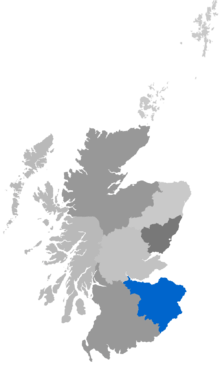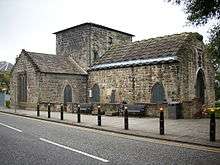Diocese of Edinburgh
Coordinates: 55°58′26″N 3°34′01″W / 55.974°N 3.567°W
| Diocese of Edinburgh Dioecesis Edimburgensis | |
|---|---|
 | |
| Location | |
| Ecclesiastical province | Scotland |
| Statistics | |
| Congregations | 57 |
| Information | |
| Cathedral | St Mary's Cathedral, Edinburgh |
| Current leadership | |
| Bishop | Bishop of Edinburgh |
| Map | |
 Map showing Edinburgh Diocese within Scotland | |
| Website | |
| dioceseofedinburgh.org | |
The Diocese of Edinburgh is one of the seven dioceses of the Scottish Episcopal Church. It covers the City of Edinburgh, the Lothians, the Borders and Falkirk. The diocesan centre is St Mary's Cathedral, Edinburgh. The Bishop of Edinburgh is the Right Revd Dr John Armes.
History
A number of important events took place in the city which put the Edinburgh diocese at the centre of the formation of the Scottish Episcopal Church. Unlike the other dioceses of the Episcopal Church which were inherited from the organisation of the Catholic Church, the Diocese of Edinburgh is a relatively recent creation, having been founded in 1633 by King Charles I, the year of his Scottish coronation. William Forbes was consecrated on 23 January 1634 in St. Giles' Cathedral as the first bishop of Edinburgh.[1]
Bishop Forbes died only three months after his consecration and David Lindsay succeeded him on the Episcopal see. At this time, the effects of the Scottish Reformation were taking a new turn and Lindsay, along with all other bishops in Scotland, was deposed in 1638 and the heritage and jurisdiction of the church passed into the hands of the Presbyterian Church of Scotland. A period of great political and ecclesiastical turmoil ensued with the Bishops' Wars and the Wars of the Three Kingdoms engulfing Scotland and England. It was not until the Restoration of the monarchy that the Episcopacy was restored to the Scottish Church and George Wishart was consecrated as the new Bishop of Edinburgh in 1662.
Episcopal rule was short-lived. In 1689 Bishop Alexander Rose (1687-1720) found himself caught up in the Jacobite conflict following the Glorious Revolution. Scottish bishops were under pressure to declare their allegiance to William of Orange over the Stuart King James VI. During an audience with the new King William in 1690, Rose's ambiguous declaration arose royal displeasure:
| “ | Sir, I will serve you as far as law, reason, or conscience shall allow me. | ” | |
| — Alexander Rose, 1690, Quoted in Clarke, "Rose , Alexander (1645/6–1720)". | |||
With Jacobite sympathies running throughout the Episcopal wing of the church, the Scottish Episcopalians were disestablished and Presbyterian polity was permanently established in the Church of Scotland. Rose departed from St Giles' Cathedral in 1689 and took with him a number of supporters from the congregation to begin a separate church. They took over a former wool store a short distance down the Royal Mile as a venue for their worship; today, Old St Paul's Church is located on this site, and claims to be the oldest Episcopal congregation in Scotland.[1][2]


For many years, Edinburgh (like the other Episcopal dioceses in Scotland) had no cathedral church. Gradually, as Non-Jurors and Qualified congregations were reconciled and the penal laws were repealed (1792), the Episcopal Church moved back into the mainstream of Scottish religious life; secret Episcopalian meeting houses were replaced by churches, a number of which served as pro-cathedrals for Edinburgh. By the late nineteenth century, the Diocese of Edinburgh was in a position to build its own cathedral through donations from wealthy benefactors, and in 1874 the foundations were laid for St Mary's Cathedral on Palmerston Place in the West End. This new cathedral, completed in 1879, was designed in the Gothic Revival style by Sir George Gilbert Scott and its three massive spires reaching 90 metres (300 ft) and 60 metres (200 ft) can be seen on the western skyline from Princes Street.[3]
The High Kirk of St Giles still stands today on the Royal Mile; while it is commonly referred to as "St Giles' Cathedral" this is an honorary title as, being a Presbyterian church, lacks a cathedra (the throne of a Bishop). It should be noted that another St Mary's Cathedral also exists in Edinburgh, the Roman Catholic Cathedral which is situated on Picardy Place at the top of Leith Walk.
Bishops
Prior to the Reformation, Edinburgh was part of the Diocese of St Andrews, under the Archbishop of St Andrews and throughout the mediaeval period the episcopal seat was St Andrew's Cathedral. The line of Bishops of Edinburgh began with the creation of the See of Edinburgh in 1633. After the break with the Church of Scotland in 1689, Bishops of Edinburgh acted as metropolitan bishops until this rank was abolished by a concordat of 1731. Since then, the Episcopal Church has been led by a Primus of the Scottish Episcopal Church elected from among any of the Scottish dioceses.[4]
Following disagreements over church polity and the failure of the Jacobite rising of 1745, there was an interruption in the line of Bishops 1739-76, and another interregnum 1784-88.
| Bishop | Dates | Notes |
|---|---|---|
| 1634 | William Forbes | |
| 1634 | David Lindsay | |
| 1662 | George Wishart | |
| 1672 | Alexander Young | |
| 1679 | John Paterson | |
| 1687 | Alexander Rose | |
| 1720 | John Fullarton | |
| 1727 | Arthur Millar | |
| 1727 | Andrew Lumsden | |
| 1733 | David Freebairn | |
| 1739-76 | Vacant | |
| 1776 | William Falconer | |
| 1784-88 | Vacant | |
| 1788 | William Abernethy Drummond | |
| 1806 | Daniel Sandford | |
| 1830 | James Walker | |
| 1841 | Charles Hughes Terrot | |
| 1872 | Henry Cotterill | |
| 1886 | John Dowden | |
| 1910 | George Henry Somerset Walpole | |
| 1929 | Harry Seymour Reid | |
| 1939 | Ernest Denny Logie Danson | |
| 1947 | Kenneth Charles Harman Warner | |
| 1961 | Kenneth Moir Carey | |
| 1975 | Alastair Iain Macdonald Haggart | |
| 1986 | Richard Frederick Holloway | |
| 2001 | Brian Arthur Smith | |
| 2012 | John Andrew Armes |
Churches
.jpg)


The Episcopalian cathedral is St Mary's Cathedral, at the West End of the city. Notable Episcopal churches in the Edinburgh diocese include Rosslyn Chapel, popularised by Dan Brown's novel The Da Vinci Code; the Priory Church, South Queensferry, the only medieval Carmelite church still in use in the British Isles; and Old St Paul's, the oldest Episcopal congregation in Scotland.
| Church | Location | Town/city |
|---|---|---|
| Anglican Chaplaincy, Edinburgh | University of Edinburgh, 1 Bristo Square, | Edinburgh |
| Christ Church, Duns | Teindhillgreen, | Duns |
| Christ Church, Edinburgh | 6a Morningside Road, | Edinburgh |
| Christ Church, Falkirk | Kerse Lane, | Falkirk |
| Ecumenical Parish, Livingston | St Paul's Church, Fernbank, | Livingston |
| Emmanuel Church, Clermiston | c/o 6 Wellhead Close (Edinburgh Capital Hotel), South Queensferry, | Edinburgh |
| Good Shepherd, Edinburgh | 13(A) Murreyfield Avenue, | Edinburgh |
| Holy Cross, Edinburgh | Quality Street, Davidson's Mains, | Edinburgh |
| Holy Trinity, Haddington | Church Street, | Haddington |
| Holy Trinity, Melrose | 20 High Cross Avenue, | Melrose |
| Old Saint Paul's, Edinburgh | 63 Jeffrey Street, | Edinburgh |
| Priory Church of St Mary of Mt Carmel | Hopetoun Road, | South Queensferry |
| Rosslyn Chapel | Chapel Loan, | Roslin |
| St Adrian, Gullane | Sandyloan, | Gullane |
| St Andrew's, Innerleithen | Church Street, | Innerleithen |
| St Andrew's, Kelso | Belmont Place, | Kelso |
| St Andrew's, Prestonpans | 2 West Loan, | Prestonpans |
| St Anne's, Dunbar | Westgate, | Dunbar |
| St Baldred's, North Berwick | Dirleton Avenue, | North Berwick |
| St Barnabas, Edinburgh | Moredun Park View, | Edinburgh |
| St Catherine's, Bo'ness | Cadzow Crescent | Bo'ness |
| St Columba's, Bathgate | Glasgow Road, | Bathgate |
| St Columba's-by-the-Castle | 14 Johnston Terrace, | Edinburgh |
| St Cuthbert's, Edinburgh | Westgarth Avenue, Colinton, | Edinburgh |
| St Cuthbert's, Hawick | Slitrig Crescent, | Hawick |
| St David of Scotland, Edinburgh | Royston Mains Place, | Edinburgh |
| St Ebba's, Eyemouth | Fort View, Paxton Terrace, | Eyemouth |
| St Fillan's, Edinburgh | 8 Buckstone Drive, | Edinburgh |
| St James the Less, Leith, Edinburgh | John's Place, Leith, | Edinburgh |
| St James the Less, Penicuik | Broomhill Road, | Penicuik |
| Church of St John the Evangelist, Edinburgh | 140 Princes Street, | Edinburgh |
| St John's, Jedburgh | The Pleasance, | Jedburgh |
| St John's, Selkirk | Shawpark Road, | Selkirk |
| St Leonard's, Lasswade | 2B Dobbie's Road, | Lasswade |
| St Margaret of Scotland, Edinburgh | 170 Easter Road, | Edinburgh |
| St Mark's, Portobello | Portobello High Street, | Edinburgh |
| St Martin's, Edinburgh | 232 Dalry Road, | Edinburgh |
| St Mary and All Souls, Coldstream | Lennel Road, | Coldstream |
| St Mary's Cathedral, Edinburgh | Palmerston Place, | Edinburgh |
| St Mary's, Dalkeith | Dalkeith Country Palace Gates, High Street, | Dalkeith |
| St Mary's, Dalmahoy | The Parish Centre, Kirknewton, | Dalmahoy |
| St Mary's, Grangemouth | Ronaldshay Crescent, | Grangemouth |
| St Michael and All Saints, Edinburgh | 26 Brougham Street, | Edinburgh |
| St Mungo's, Balerno | Ladycroft, | Balerno & Currie |
| St Mungo's, West Linton | Biggar Road | West Linton |
| St Ninian's, Edinburgh | Comely Bank, | Edinburgh |
| St Paul's and St George's Church | 10 Broughton Street, | Edinburgh |
| St Peter's, Galashiels | Abbotsford Road, | Galashiels |
| St Peter's, Linlithgow | 153 High Street, | Linlithgow |
| St Peter's, Lutton Place, Edinburgh | Lutton Place, | Edinburgh |
| St Peter's, Musselburgh | High Street, | Musselburgh |
| St Peter's, Peebles | Eastgate, | Peebles |
| St Philip's and St James, Edinburgh | 57B Inverleith Row, | Edinburgh |
| St Salvador's, Edinburgh | 61 Saughton Mains Street, | Edinburgh |
| St Thomas', Edinburgh | 79 Glasgow Road, | Edinburgh |
| St Vincent's, Edinburgh | St Stephen Street, | Edinburgh |
Twinning
The Diocese of Edinburgh is twinned with the dioceses of two other churches:
 Anglican Diocese of Dunedin (Anglican Church in Aotearoa, New Zealand and Polynesia)
Anglican Diocese of Dunedin (Anglican Church in Aotearoa, New Zealand and Polynesia) Diocese of Connor (Church of Ireland)
Diocese of Connor (Church of Ireland)
References
- 1 2 "History of the Diocese". Diocese of Edinburgh official website. Retrieved 4 October 2012.
- ↑ "A History of Old Saint Paul's". Old Saint Paul’s parish website. Retrieved 4 October 2012.
- ↑ "History". St Mary's Cathedral website. Retrieved 6 October 2012.
- ↑ Bertie, David (2001). Scottish Episcopal Clergy, 1689-2000. Continuum International Publishing Group. p. 561. ISBN 9780567087461. Retrieved 5 October 2012.